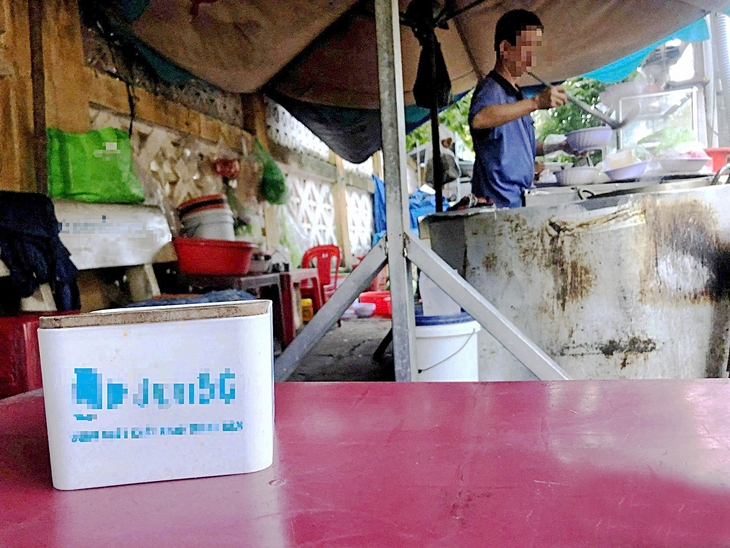Why are gambling advertisements still dominating public spaces despite being legally prohibited?
Recently, traveling along national highways or stopping at any restaurant or coffee shop, it’s not difficult to encounter sun umbrellas completely covered with logos, QR codes, and unusual symbols leading to online betting sites.
Even tissue boxes, chopstick containers, and menu boards have become places for these prohibited business services. When these small pieces are put together, we can see the full picture of how online gambling and betting advertisements have deliberately infiltrated our living spaces.
Why are gambling advertisements still dominating public spaces?
Why do gambling advertisements continue to dominate public spaces and even popular cultural products like music videos when the law already prohibits advertising for banned business services? From management agencies to shop owners, artists, digital platforms, and individual internet users – how can we protect safe spaces for children, workers, and communities from this social evil?
Recently, a digital currency gambling case brought to trial in Ho Chi Minh City revealed the hidden part of the iceberg – where technology allows rapid expansion while advertising serves as the most effective trap.
The root of the problem isn’t the absence of laws. The Advertising Law already prohibits advertising for banned goods and services. Illegal betting and gambling naturally fall into this category.
The act of organizing gambling already constitutes a crime in the Penal Code. Administrative penalties and remedial measures for illegal advertising have been specified quite specifically in Decree 38/2021/ND-CP.
The problem lies in the fact that advertising today is no longer just roadside billboards but has become extremely diverse – from outdoor advertising, in-store promotions, on digital platforms, to entertainment content…
If we only remove a few signs and penalize a few shop owners while allowing the main distribution channels on digital platforms and intermediary payment cycles to slip through, the problem will quickly regenerate.
Currently, three shortcomings exist. First, thinking removal is enough. Removing umbrellas and signs only addresses the surface while the bait lies in QR codes and links. Without blocking distribution sources on digital platforms, today’s cleared spots will reappear elsewhere tomorrow.
Second, penalty levels are too light. Fines lower than profits make violators treat penalties as business costs, allowing disguised advertising to continue.
Third, blaming the loudest voices. This perspective overlooks systemic responsibility from MV content approval before release, post-publication platform monitoring, and brand safety rules binding both producers and publishers.
Compared to many countries, Vietnam hasn’t fully utilized advertising chain control tools in the digital era. Major platforms in the EU are forced to quickly remove illegal content, transparently disclose distribution algorithms, and open API data interfaces for authorities and researchers under obligations like the Digital Services Act.
Many countries block payments to and from unauthorized gambling websites through blacklists. They require app publishers to block promotional keywords and strengthen KYC requirements for e-wallets to cut off money flow channels.
Need for a synchronized mechanism covering data, platforms, payments, and intermediary responsibility
Vietnam has prerequisites in cybersecurity and telecommunications, but to effectively combat gambling advertisements, we need a synchronized mechanism covering data, platforms, payments, and intermediary responsibility.
From a policy perspective, solutions should start with mapping the advertising ecosystem to clearly define legal roles from advertising space lessors, advertising publishers, advertising agencies, KOLs, artists, digital platforms, to payment providers.
Simultaneously, attach responsibility for checking advertising conditions and KYA obligations similar to KYC in finance. Establish clear notification, removal, and blocking mechanisms with progressive penalties for repeat offenses.
The legal framework has clearly defined the rights and obligations of publishers and space lessors, but operational guidelines are lacking for grassroots levels when encountering suspicious logos and QR codes – standard procedures for verification, documentation, removal, reporting with photos, coordinates, and digital evidence preservation are needed.
In enforcement, an inter-sectoral campaign to clean up disguised advertising is needed with three key focuses:
(1) Block money flow, monitor and lock transactions to and from payment gateways, e-wallets, and accounts related to illegal betting platforms.
(2) Block distribution channels using keyword filters, logo recognition patterns, symbols, QR codes, and sharing blacklists with platforms, network providers, and app stores.
(3) Increase penalty levels for violating organizations, individuals, and businesses, strictly handle artists and producers who intentionally embed gambling identifiers in their works.
Media





